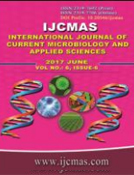


 National Academy of Agricultural Sciences (NAAS)
National Academy of Agricultural Sciences (NAAS)

|
PRINT ISSN : 2319-7692
Online ISSN : 2319-7706 Issues : 12 per year Publisher : Excellent Publishers Email : editorijcmas@gmail.com / submit@ijcmas.com Editor-in-chief: Dr.M.Prakash Index Copernicus ICV 2018: 95.39 NAAS RATING 2020: 5.38 |
Rice-wheat is a major cropping system prominent on 2.5 million hectares in Punjab. Irrigation is commonly used to stabilize the productivity of this system using surface canal and sub-soil tube well water. Judicious use of water and land resources has been a major challenge for agriculture and it is imperative to use these scarce resources efficiently. This paper describes various alternative cropping systems being adopted by a progressive farmer to attain the goal of raising productivity and meeting food security needs along with efficient use of natural resources including water, providing environmental benefits and improving the rural livelihood of farmers. The results of investigations reveal that vegetable based cropping systems and horticultural crops gave higher rice equivalent yield as compared to rice-wheat cropping system. The data on economic viability and profitability of various cropping systems indicated the highest net returns under rainy season bottle gourd-summer squash cropping system (Rs 6,06,075/ha), which was followed by rainy season bottle gourd-capsicum and rainy season bottle gourd-tomato cropping system. Rice-wheat recoded the lowest net returns (Rs.1, 29,963/ha). The B: C ratio of different cropping systems varied from 2.87 to 4.84 and predominant rice-wheat cropping system showed B: C of 3.24. It may be concluded that the vegetable and horticultural based cropping systems are biologically efficient and highly profitable, however; Punjab farmers’ still prefer rice-wheat sequence due to their better stability and assured marketing.
 |
 |
 |
 |
 |